'What is needed is a clear signal for the energy sector to transform itself'
on
‘What is needed is a clear signal for the energy sector to transform itself’
‘Ringing the alarm bells’. That is how Fatih Birol, Chief Economist of the International Energy Agency, sums up the underlying message coming from the new 2010 edition of the World Energy Outlook (WEO), the annual flagship publication of the International Energy Agency (IEA) that was published on Tuesday. For the first time, Birol and his team calculated what would happen if the world’s governments continue to follow the weak climate change policies they are following now. The long-term result, according to the WEO, would be a 3.5 degrees rise in global temperatures. In short: disaster. ‘What is needed very badly’, says Birol, ‘is a clear signal for the energy sector to transform itself’. Birol, who does not drive a car ‘out of ideological reasons’, has started on a tour of European capitals with his team to present the results of the WEO. EER caught up with him on Wednesday in The Hague.
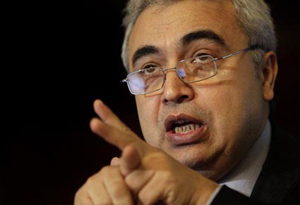 |
| IEA's chief economist Fatih Birol |
This is quite true. If we compare the size of recent editions, we see that the WEO grows along with the world’s energy consumption:
WEO 2010: 731 pages
WEO 2009: 691 pages
WEO 2008: 578 pages
WEO 2003: 511 pages
WEO 1993, the first edition: 76 (!) pages
The content and scope of the report have also gradually changed. It used to focus primarily on the development of the energy demand and supply (mainly of oil and gas) of the OECD countries – the IEA being of course an OECD organisation. Over the course of time, it has become much more wide-ranging, covering the entire energy sector (including renewables as well as the issue of climate change) and the entire globe. This is not a coincidence: to stay relevant, the WEO had to follow the market – which has become ever more globalised and whose centre of gravity is shifting more and more from OECD countries to non-OECD countries like China, India, Brazil, Russia, Turkey and Saudi Arabia.
Failure of Copenhagen
As it has become broader, has it also become more reliable? It is easy of course to criticise the WEO for some of the “predictions” that did not come true, but that would not be fair. From the very start, the WEO has been structured as a scenario study. In other words, the report should be used as a tool to understand how the world’s energy future will develop under certain policy assumptions.
In its most recent editions, the WEO presented two basic scenarios: the “Reference” or business-as-usual scenario and the so-called “450” scenario. The latter is based on the assumption that governments carry out all the policies required to contain the global CO2-concentration at 450 parts per million (ppm). This, according to the IPCC, the climate body of the United Nations, would limit average global warming to 2 degrees Celsius – an increase that would have enormous consequences for the earth, but would presumably just stop short of disaster.
However, the “450” scenario was only likely to become a reality if the UN climate conference in Copenhagen last year had ended in a resounding success. Instead, as Fatih Birol puts it starkly, ‘it ended in failure’. As a result, he says, people ‘were telling us that neither of our two scenarios was very realistic’. The business-as-usual scenario was too pessimistic, since governments were at least making some attempts at emission reductions, but the 450 ppm scenario was too optimistic. For this
| ‘The consumer countries may be unable to increase oil production, but they can have a profound impact on the oil market – by moving to advanced car technologies’ |
The outcome of this New Policies Scenario (NPS), presented in the WEO 2010, may be more ‘realistic’ than that of the 450 scenario, it is, however, far from reassuring, according to Birol. In the long-term it would lead to an increase in the concentration of greenhouse gases from about 390 ppm today to 650 ppm in the future. That in turn would lead to a ‘likely temperature rise of more than 3.5 degrees Celsisus in the long term’, says the WEO. Obviously an alarming prospect, to say the least. ‘This is not good for anybody, neither for energy producers nor consumers’, says Birol. ‘That is why we are ringing the alarm bells strongly with this report.’
Cutting back
At this moment, says Birol, there are very few governments in the world taking the actions that are needed. ‘I don’t see any momentum in climate change policies. Nothing is moving.’ To Birol it is clear that change has to start with governments taking action. They have to set the right conditions for energy companies to make the right moves. ‘What is needed very badly’, he says, ‘is a clear signal for the energy sector to transform itself. I don’t hear this signal right now.’ And this should be done not only to prevent disastrous climate change, he adds, but also for the sake of security of supply.
One thing that governments should do, says the famous energy economist, is to give support to renewable energy. Birol: ‘Renewable energy can go mainstream, but only if it gets government backing. The renewable energy industry is still young. It cannot be compared to the oil and gas industry. It needs to be nurtured. If governments take away their support, it will get hit badly.’
In the WEO 2010, the IEA has calculated for the first time the amount of subsidies that go to renewable energy worldwide: $57 billion in 2009. That seems a relatively low figure. Under the assumption of the New Policies Scenario (NPS), this is bound to increase to $205 billion in 2035, still just 0.17% of global GDP.
Interestingly, in this year’s WEO, the IEA also takes a detailed look at the subsidies governments spend on fossil fuel consumption worldwide. These amounted to $312 billion in 2009 and a hefty $558 billion
| ‘China has the power to transform the global energy system in a clean direction’ |
The reality, however, is that many governments in non-OECD countries find it hard to wean their population off oil and gas subsidies, while governments in OECD countries are currently cutting back on their support for renewables, for bugetary reasons. What makes matters even worse for the renewable sector are the low prices of natural gas at the moment. They seriously hamper investment in renewable energy, as gas-fired power stations compete directly with wind power, solar power, and biomass. In the US, says Birol, it is already clear that 2010 will be one of the worst years for investment in renewable energies in recent times. ‘We see a big decline in renewable energy investment in the US.’
Given solid government backing, the WEO is optimistic about the prospects for renewables in the power production sector. In the New Policies Scenario, the share of renewables in electricity production will increase from 19% in 2008 to almost one-third in 2035, about equal with coal, primarily thanks to growth in wind and hydropower. The contribution of solar power will stay limited. The share of nuclear power in electricity production will rise, but not very much – from 6% today to 8% in 2035. Birol does believe nuclear power has an important contribution to make to our energy future. Yet, despite this, and despite the much talked-about nuclear renaissance, it is clear that nuclear power will not save the world.
Intriguingly, the country that is showing the most progress in renewable energy is China. ‘That was a surprise to us’, says Birol. ‘We knew China was very important in terms of energy demand, but we have now found that China is also becoming increasingly important on the supply side. China has the power to transform the global energy system in a clean direction.’
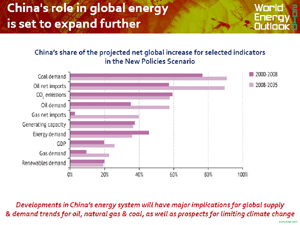 |
| China's role in global energy is set to expand further Source: World Energy Outlook 2010 |
Peak oil
According to the WEO, a ‘fundamental shift in transport technology’ is needed to limit growth in oil consumption. All of the projected growth in oil consumption, Birol notes, comes from the transport sector. ‘China could make a major transformation possible if it switched to electric cars’, he says. But consumer countries in the west can make a difference too. ‘The consumer countries may be unable to increase oil production, but they can have a profound impact on the oil market – by moving to advanced car technologies’.
In fact, the WEO strongly urges governments of consuming countries to take measures to reduce oil consumption. Otherwise, the report notes, they will face a ‘peak in oil production’ that ‘will come not as an invited guest, but as the spectre at the feast.’
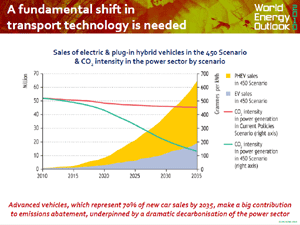 |
| A fundamental shift in transport technology is needed Source: World Energy Outlook 2010 |
So what about peak oil? Under the New Policies Scenario, ‘crude oil output’, states the WEO, ‘reaches an undulating [i.e. wave-like] plateau of around 68-69 mb/d [million barrels per day], but never regains its all-time peak of 70 mb/d reached in 2006.’ In other words, as Birol confirms, crude oil production has already peaked in 2006 – at least in the New Policies Scenario.
This does not mean, however, that total oil production will not grow anymore under this scenario. In fact, it will reach 96 mb/d in 2035, about 12 mb/d higher than in 2009. This growth comes from unconventional oil production (chiefly oil sands in Canada) and from natural gas liquids (which are a byproduct of gas production, mainly in the Middle East).
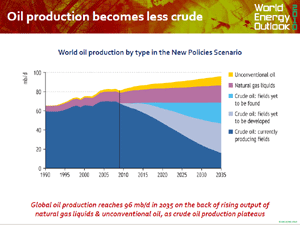 |
| Oil production becomes less crude Source: World Energy Outlook 2010 |
So, according to the WEO, there is no real oil peak in sight, contrary to what the peak oil proponents claim. But, the report adds, the business-as-usual scenario is a far from desirable scenario. The WEO
| ‘In the US it is already clear that 2010 will be one of the worst years for investment in renewable energies in recent times’ |
One reason for this dire warning is not just that oil production is becoming more difficult and is harmful to the climate, but also that production is shifting inexorably away from the OECD countries to the OPEC countries. The WEO makes the important point that production from existing oil fields will decline, under the New Policies Scenario, from 68 mb/d in 2009 to a meagre 16 mb/d in 2035. To reach the ‘plateau’ of 68-69 mb/d requires production from new oil fields. The problem with this is that, as Birol says, most of the rapidly declining fields are in the hands of the western oil majors such as ExxonMobil, Shell, BP, Total and ENI, whereas growth from new fields will come mainly from OPEC countries (in addition to e.g. Brazil and Kazakhstan). As Birol puts it: ‘More oil from fewer producers’. The share of OPEC in total oil output wil rise from 41% now to 52% in 2035 – ‘a market share not seen since just before the oil price shocks of the 1970s’, notes Birol.
Sombre messages
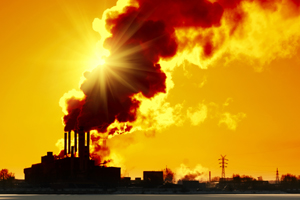 |
| 'China has the power to transform the global energy system in a clean direction’ |
So these are rather sombre messages for the future of the oil market. What about the gas market, which some of the “Big Oil” companies are putting their money on these days? On this, the WEO is much more upbeat. ‘China could lead us into a golden age for gas,’ it proclaims. That is, if gas demand in China were to rise substantially.
According to the WEO, gas is the only fossil fuel that will see higher demand in 2035 under the New Policies Scenario. Demand will grow 1.4% per year on average, or 44% in total, compared to 2008. And this could even be higher, if China were to replace some of its huge coal-fired power capaicty with gas-fired plants.
Not all the news is good for Big Oil, though. First of all, again most of the supply growth will come from the Middle East, i.e. the OPEC countries. The Middle East countries will see their output double to 800 billion cubic metres in 2035, which is almost 20% of total world production, notes the WEO. In addition, some 35% of the growth will come from unconventional gas, in particular thanks to the development of coal-bed methane in Australia.
Secondly, gas prices are not likely to recover from their current low levels any time soon. The ‘gas glut’
| ‘I don’t see any momentum in climate change policies. Nothing is moving’ |
Clearly under the the New Policies Scenario oil and gas prices will continue to diverge even further. The implication of this is that pressure will mount on gas suppliers to abandon long-term gas contracts based on oil-price linkage and replace them with other types of indexations or base them on spot market prices.
Better planet
Although we have obviously just managed to scratch the surface of the WEO 2010, we would like to know from Fatih Birol what some of the most important conclusions are that he takes away from this year’s report.
He mentions four:
-Recent climate policies fall well short of what is needed to achieve a secure and clean energy future.
-The ‘lack of ambition’ in Copenhagen last year makes achieving the 2 degrees C target less likely.
-‘The age of cheap oil is over.’
-Government policies might mitigate oil price rises.
As it turns out, Birol, who is known for his factual presentations, turns out to feel deeply about the climate change issue. When asked, he says he does not drive a car, out of idealistic reasons. ‘I try to live not in contradiction to my policy prescriptions’, he says. ‘What motivates me? I want to see a better planet.’
|
Who is Fatih Birol?
Fatih Birol, born in Ankara in 1958, is Chief Economist at the International Energy Agency (IEA) in Paris. He earned a BSc degree in Power Engineering from the Technical University of Istanbul and an MSc and PhD in energy economics from the Technical University of Vienna. Before he joined the IEA in 1995, he worked for OPEC in Vienna for six years. He has received awards from many governments, including those of France, Austria, Germany, Poland, the Netherlands, Russia and the US. He is also Chairman of the Energy Advisory Board of the World Economic Forum. |


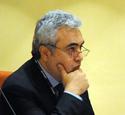
Discussion (0 comments)